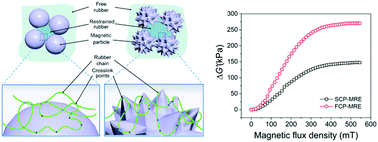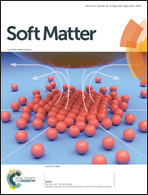Improved tunable range of the field-induced storage modulus by using flower-like particles as the active phase of magnetorheological elastomers†
Abstract
The field-induced storage modulus is an important parameter for the applications of magnetorheological (MR) elastomers. In this study, a model mechanism is established to analyze the potential benefits of using flower-like particles as the active phase compared with the benefits of using conventional spherical particles. To verify the model mechanism and to investigate the difference in dynamic viscoelasticity between MREs with spherical particles and flower-like particles, flower-like cobalt particles and spherical cobalt particles with similar particle sizes and magnetic properties are synthesized and used as the active phase to prepare MR elastomers. As the model predicts, MREs with flower-like cobalt particles present a higher crosslink density and enhanced interfacial bond strength, which leads to a higher storage modulus and higher loss modulus with respect to MREs with spherical cobalt particles. The tunable range of the field-induced storage modulus of MREs is also improved upon using the flower-like particles as the active phase.



 Please wait while we load your content...
Please wait while we load your content...